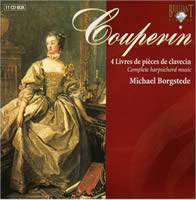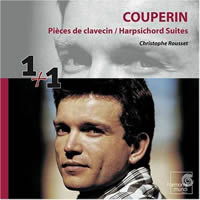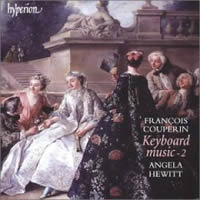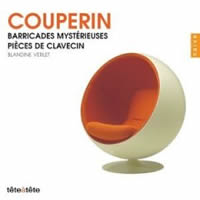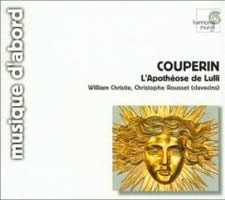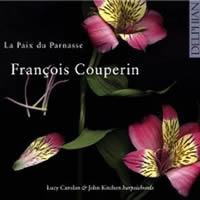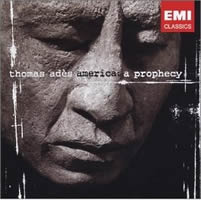Pièces de Clavecin 1: Francois Couperin
|
Grant Chu Covell [May 2007.] As with the Bachs in Saxony, the Couperins were France’s leading musical dynasty during the Baroque era. The first musical Couperin was a farmer, but his progeny, male and female, taught French royalty and kept an organ post in the family for 173 years at the Church of Saint-Gervais in Paris. Important Couperins include Louis (1626-1661), Armand-Louis (1727-1789) and of course the most celebrated of all, François “Le Grand” (1668-1733), admired and commemorated by many later composers, including Brahms, Strauss and Ravel. Regarded as the most important French composer between Lully and Rameau, François Couperin’s harpsichord music epitomizes French Baroque style and technique. It was he who insisted upon using the thumb at the keyboard, a quickly adopted practice replacing a prior eight-fingered technique viewed today as incomprehensible. Before “Le Grand,” music for clavecin — far less popular than the viol — was modeled on lute music, predominantly dance movements organized into suites. In his four published books of “Pièces de clavecin” (1713, 1717, 1722 and 1730), Couperin distanced himself from precedents in grouping his pieces by key (major/minor relationships) called ordres. Over 200 pieces span 27 ordres. Fancifully titled, many are portraits or descriptive miniatures, though dance forms are never terribly distant. Ironically, many titles are now unfathomable. Couperin freely employed puns, anagrams and topical moments. Additionally, feminine titles are gender-ambiguous, e.g., “la pièce.” La Couperin (Book Four, ordre 21) can as easily refer to a male or female Couperin. Couperin’s complete keyboard works, the four books’ 27 ordres plus the eight Preludes and Allemande from the pedagogical L’Art de toucher le clavecin (1716) can occupy 11 CDs. How best to approach the oeuvre? On harpsichord, Couperin’s intended instrument, or piano? Excerpts or complete ordres? As usual, the issue boils down to taste, and to some degree fortitude. The completist would of course require l’intégrale, better to savor Couperin’s development, however many pieces have entered the repertoire on their own. Sheet music is easily obtainable. Among modern editions, the Dover Publications reprints of the 1888 Brahms and Chrysander edition span two volumes, Complete Keyboard Works, Series I and II (ISBN 0486257959 and 0486257967). Prefatory material includes a necessary explication of ornaments, along with a glossary. Some favorite pieces can be downloaded free of charge from specialty Internet sites.
As an entity, harpsichordist Michael Borgstede’s set (Brilliant Classics 93082) is the obvious frontrunner. Prior intégrales from Olivier Baumont, Kenneth Gilbert, Scott Ross, Christophe Rousset, Noëlle Speith and Blandine Verlet are O/P. Some reissued excerpts exist. Harmonia Mundi wisely released a two-disc budget collection with Rousset’s complete ordres 4, 6, 11, 13, 18, 25 and 27 (Harmonia Mundi HMX 2901885.86). Naïve takes a skip-stop route through Verlet’s 1976/81 recordings, exposing unsettling differences in instruments and tunings (Naïve E 3003), and Warner has assembled some Baumont. Borgstede’s regal and forthright Couperin are model performances, perfect for the newcomer who would do no wrong in acquiring the set and working his or her way through several ordres at a time. However, interpretative panache is always an important consideration, and we should be grateful to Harmonia Mundi for the invigorating Rousset reissue. As to the piano, recent leading contenders are Alexandre Tharaud’s well-executed single-disc assortment (“Tic, Toc, Choc,” Harmonia Mundi HMC 901956) and the prolific Angela Hewitt’s three (Vol. 1: Hyperion CDA67440; Vol. 2: Hyperion CDA67480; Vol. 3: Hyperion CDA67520). It would seem that pianists prefer samplers, whereas harpsichordists take ordres on in their entirety. Perhaps this reflects the commitment of fans of the French Baroque who appear more inclined to invest in a harpsichord intégrale. Lacking that instrument’s inherent crispness, can Couperin withstand pianistic rubato and pedaling? Tharaud’s collection argues well. Hewitt, who tackles several complete ordres among scattershot excerpts, is more successful when aiming at completeness. Plunging into the Le Grand Top Ten, Les Barricades Mistérieuses (ordre 6) ranks high. Recent movie soundtrack appearances include Marie Antoinette. I’ve yet to hear a perfect rendition. Borgstede, Rousset and Verlet take this “Rondeau vivement” slowly (2:59, 2:37 and 2:43). Tharaud canters through it (at 1:40) at his recital’s incipit, as if to get the chore behind him. Hewitt applies heavy pedal (2:28). The best pacing would reel it in close to the two-minute mark, and it can indeed be performed on the piano, but with sparing pedal. I’ve been fortunate to hear Rousset play it live, and he applied registration colors, reprising the rondeau on the upper manual. What does Les Barricades Mistérieuses mean? No one knows for sure. Most obviously, the player’s hands spend their time among narrow bass-clef ranges. Perhaps the title refers to a contemporaneous stage play. Hewitt reports a citation that deciphers the “mysterious barricades” as chastity belts or underwear! A useful explicator is “The Mirror of Human Life”: Reflections on François Couperin’s Pièces de Clavecin, a modest tome by Jane Clark and Derek Connon published by King’s Music (http://www.kings-music.co.uk/). As written, another favorite, which takes its title from Tharaud’s collection, Le Tic-Toc-Choc ou Les Maillotins (ordre 18), is nigh impossible to play on the piano. This “pièce croisée” requires two manuals, permitting the hands to operate in overlapping ranges. An eminently practical musician, Couperin encourages players to alter the octave of either hand. In fact, he was generous with respect to what instruments could play his music. Hewitt takes Le Tic-Toc-Choc rather dryly; Tharaud is bright. It’s also the second item in his collection — perhaps he’s dispatching pro-forma favorites in order to get at the meat. While Hewitt strikes at some big faves in her first go at the complete ordres 6, 8 and 18, it’s not the best of her three discs. Vol. 1 reveals uneven tempos and an inconsistent touch, suggesting hurried sight-reading. It’s baffling that so many reviewers celebrate her abilities. Both Hewitt and Tharaud attempt ordre 8’s closing Passacaille, a sumptuous theme and variations that, except for the ornaments and chromaticism, could be taken for Handel. Tharaud’s grand execution focuses upon the ritornello with its yearning, almost whole-tone melody (D – E – F# – G# – A – G# – A# – B); showing little passion, Hewitt dawdles among the couplets. Recorded several months later (Vol. 1 is dated 12/2002, Vol. 2 7/2003), Hewitt’s second release explores Book Four (1730), presenting ordres 21, 25, 26 and 27 in their entirety and part of ordre 24. Here the performer is more elegant and conscientious, but then again, Couperin’s darker and more melancholic fourth book contains moods compatible with sustaining pedal. Ordre 25 is especially poignant in this regard. It opens with an archetypical French overture, La Visionaire, which a naïve listener, unaware that he closely studied the French models, might mistake for something by J.S. Bach. (Legend has it that the Bach-Couperin correspondence was recycled to cover jam jars!) The ordre’s Les Mistérieuses, no apparent connection with Les Barricades, offers some unexpected chromatic dissonance that quite evaporates on the harpsichord but which, via piano, invites lingering, an opportunity Hewitt misses. Later she smudges poignant harmonies in the ordre’s exquisite closing Les Ombres Errantes. Check in with Tharaud, who programs La Visionaire and Les Ombres Errantes, to hear how he weighs each dissonance. I’ve heard Rousset play this complete ordre live and it was very fine. Clavecin discords evaporate quickly, requiring specialized techniques (depressing keys extra long so strings ring just a little more, arpeggiating chords to articulate pitches, etc.). Hewitt’s final Le Grand installment (recorded 9/2004) follows a complete ordre 8 with a smattering of excerpts. Three discs down, Hewitt clearly does better at complete ordres than at potpourris. More to the point, her technical choices suggest that Couperin doesn’t translate well to the piano. Besides an over-reliance on pedal, she plays explicitly indicated ornaments as if gnats to be brushed away. Hewitt renders Les Lis naissans (ordre 13) mechanically, without nuance. Conversely, Tharaud appears to consider each ornament differently, adding accents, slowing here, speeding there. His pedal-and-rubato touch is undeniably Romantic. Where Hewitt plows through, Tharaud interprets, altering mordents or octaves on repeats, confidently taking liberties with what Couperin proposed for two players (three staves are notated), likewise performing the Muséte de Taverni (ordre 15) with three extra hands (overdubbed improvisation), adding a drum to the Bruit de guerre (from ordre 10’s La Triomphante). Typical of his thoughtful recitals, Tharaud adds an encore, Jacques Duphly’s La Pothouïn. In for the long haul, Borgstede prefixes the first eight ordres with a Prelude from L’Art de toucher le clavecin. Borgstede joins with Haru Kitamika for the two-harpsichord Allemande that opens ordre 9. Violinist Sophie Gent takes the third line of ordre 14’s La Julliet, ordre 15’s musétes, and several other pieces. Joshua Cheatham appears with viola da gamba in ordre 21’s La Croûilli. The string colors startle at first but do enliven the landscape. I suspect that Couperin would have approved. An accomplished player, Borgstede eschews Rousset’s dramatics. The singing line of ordre 14’s Le Rossignol-en-amour expands and contracts, but doesn’t sway. Where others may dash through the evidently insignificant Le Petit-Rien, Borgstede discovers simple enjoyments. Beyond uniformly firm realizations, Borgstede’s current advantage among Couperin intégrales is the Brilliant box set’s attractive price and the absence of readily available competition.
While Naïve’s Verlet repackaging certainly demonstrates the instrumentalist’s vivacity, the assortment’s dislocated ordering reveals strong differences between instruments and tunings from one track to the next. Lacking commentary, this budget reissue refers the purchaser to a defunct website, further compounding helplessness. The music is what counts, and Verlet’s set has its gems, among them the eighth ordre Passacaille, employing a spicy non-ET tuning that nicely colors its straying top line. Firmly established both as a leading Baroque keyboardist and conductor, Rousset’s repertoire has grown beyond his early cranked-out keyboard intégrales of Couperin, Rameau, Royer, et al. While the HM collection offers great contrast to Borgstede, the few ordres prove frustrating. Couperin’s keyboard works merit a deep soak and exploration which only Borgstede permits. For contrast, if you take (say) Tharaud’s recital, you ought to have Rousset on hand for comparison. A sprightly La Julliet (ordre 14) is among a few two-harpsichord pieces which complete Harmonia Mundi’s reissue HMA 1951269, “L’Apothéose de Lully,” featuring William Christie and Rousset (originally HMC 901269, recorded in 1987). The non-ET tuning won’t agree with everyone, and there are moments such as in L’Apothéose de Lully’s Plaintes des Mêmes where it sounds as if the harpsichords (a 1976 Anthony Sidey and a 1985 Bruce Kennedy after Taskin) aren’t in tune with each other. Nonetheless, the duo’s playing is delightfully eccentric. Arguably the trio sonatas L’Apothéose de Lully, Le Parnasse ou L’Apothéose de Corelli and La Paix du Parnasse may satisfy traditionalists in more standard chamber music formations (here Borgstede offers a strong case with Musica ad Rhenum in a complete set of Couperin’s chamber music on Brilliant 92178), but in traditional formations, Couperin’s lines can become easily blurred as in Hespèrion XX’s (Astreé E7709 with Monica Huggett, Chiara Banchini, Jordi Savall, Ton Koopman, Hopkinson Smith and Bernard Hervé narrating). The clattering harpsichords do a far better job representing L’Apothéose de Lully’s purposefully theatrical “subterranean rumble” than do strings. Delphian offers a stately duo-harpsichord recital featuring Lucy Carolan and John Kitchen (DCD34012) in several duo and solo pieces selected from the ordres and Concerts Royeaux, including the entire La Paix du Parnasse, Concert Royal No. 3 and La Steinquerque. The remote-sounding instruments (a 1769 Taskin and a 1764/83 Goermans/Taskin) may soothe those assaulted by the vigor of the Christie / Rousset recital, though some pieces, such as La Létiville (ordre 16), do benefit from the Christie-Rousset punch or the violin joining Borgstede. Carolan and Kitchen do their best work in La Steinquerque. I’d certainly put Mitzi Meyerson among harpsichordists I’d like to see recording more Couperin. The wish is based on a lively turn at ordre 13’s extended variation set, Les Folies Françoises ou les Dominos (Harmonia Mundi HMU 907081, with members of La Sonnerie playing Couperin, Clérambault, Montéclair and La Sonnerie’s “theme song,” Marais’ La Sonnerie de Ste. Geneviève du Mont de Paris). Jumping across the centuries, a reconsideration of Strauss, Op. 86, the Divertimento for small orchestra after Couperin: Enamored of Le Grand’s miniature tone poems, Strauss visited these pieces throughout his career, reusing several orchestrations to form the 1923 Dance Suite, the 1940 Bygone Festivities and the 1942 Divertimento. Strauss’ late-Romantic hand bizarrely pairs oboe with horn in Le Tic-Toc-Choc, though he does recognize identical chord progressions and layers Le Tic-Toc-Choc with La Lutine. Elsewhere, as in the deceptively simple two-part Les Ombres Errantes, the composer adds a stifling impasto (doubled lines, additional countermelodies) to Couperin’s fine porcelain. The best Couperin orchestration I know belongs to Thomas Adès: An elegant 1994 Les Barricades Mistérieuses configured for clarinet, bass clarinet, viola, cello and double bass on his uneven “America” release (EMI 5 57610 2). On April 22, 2007, the Chamber Orchestra of Europe gave the UK premiere of his 2006 Three Studies after Couperin.
[More Grant Chu Covell, Pieces de Clavecin]
[Previous Article:
Ferneyhough & Stockhausen: Grubby and Gruppen]
[Next Article:
Goldberg Variations at Steinway Hall, Saturday, April 28, 2007]
|
